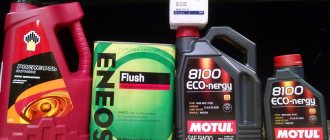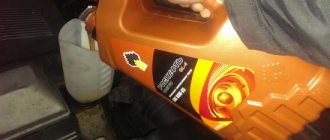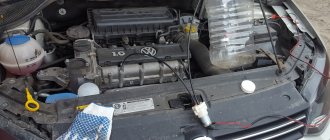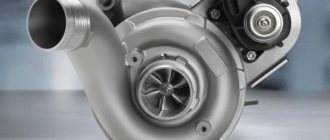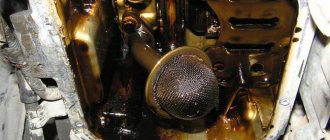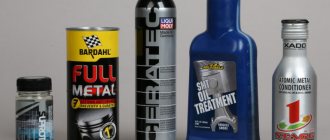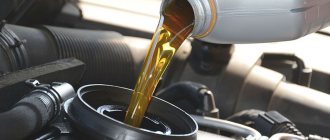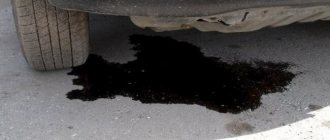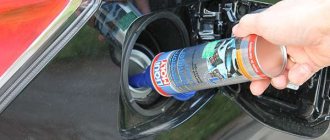One of the options for extending the “life” of the engine, according to car market sellers, is engine oil additives, because every car owner tries to keep their unit in full working order.
And each of them wants to minimize the cost of servicing the machine, as well as to maximize the service life before major repairs, this is especially true for the power plant.
But are oil additives really a “lifesaver” for an amateur? Let’s try to figure it out.
Let's start with the fact that in general two types of additives are produced:
- In fuel;
- Into the engine oil.
Each of these types of additives is designed to perform certain functions in the engine.
Additives added to fuel
There are not so many fuel additives produced, if you take only certified products. Although the so-called fakes of the car market can offer a myriad of additives, most of them fake.
If we take only high-quality engine additives that are added to fuel, then they can be divided into three groups that differ in their properties:
- The first group of fuel additives includes cleaning additives, which in turn are divided into two subgroups: additives that clean all channels and lines of the fuel system, and additives that clean existing deposits on the cylinder-piston group and on the valves;
- The second group of additives is designed to remove water present in the fuel tank;
- The third ensures an increase in octane number, thereby improving the quality of gasoline.
If there is nothing special to say about the first two groups of chemical additives, then about the third group it should be noted that it is the most counterfeited, and when deciding to purchase it, you need to choose additives from this group carefully.
At best, the additive will not have any effect; at worst, it will lead to negative results and failure of engine components.
Additives added to oil
Types of additives.
Next comes engine oil additives. These additives are added to the lubrication system, and according to the sellers, they have a positive effect on components and mechanisms.
Engine oil additives are also offered in several groups, divided among themselves according to their functions.
To the first group.
These include engine oil additives that perform a cleaning function. These additives are designed to clean oil channels from tar deposits.
Additives of the second group.
Intended for use in the engine during the break-in period. The purpose of these additives is to improve the grinding in of components and mechanisms with each other during running-in.
Third group.
Engine oil additives of the third group are designed to reduce friction between components, thereby influencing the parameters of the power plant.
Fourth group.
These include so-called restorative additives. According to manufacturers, they allow, to some extent, the restoration of worn-out layers of metal of mechanism parts with increased friction.
This action of the additive leads to an increase in the service life of the motor before major overhaul.
Rules for choosing engine additives
Manufacturers of various additives are confident that the product they sell can increase the service life of the engine.
However, the opinion of Russian car owners about the properties of additives is divided. Some believe that the additive saved them from major engine repairs. Others are sure that this is a waste of money. Obviously, even the best engine additive will not help if the engine is completely worn out.
The use of the additive is preventive in nature and allows you to eliminate minor breakdowns in the engine.
The additives produced today are highly specialized. Information about what exactly they are intended for is contained on the packaging. But rarely does anyone read the instructions from the manufacturer; usually the car owner simply fills in the additive, but what he gets is not at all what he expected. Which engine additive is best? To answer this question, you need to consider the following points:
- Decide what you need the additive for . If an engine consumes too much oil, it does not need a compression additive. Better choose sealants.
- The additive will help if the car is noisy and smokes . The main thing is to choose an additive that is suitable for your engine. What is important here is both the type of engine - gasoline or diesel - and the oil - mineral, semi-synthetic, synthetic.
- What additives are best for engine restoration if the car service center told you that the engine is “killed” ? This is where a remetallizant additive can help. It contains metal microparticles that protect the engine surface from the inside. Thanks to this additive, the gaps will become smaller, the car will start easily, and traction will appear. However, such an additive will not last long: several tens of thousands of kilometers.
To find out which engine oil additives are best, read the review below. The top best additives include only those additives that have gained popularity among Russian car enthusiasts.
We recommend
Chemical composition
The above describes oil additives divided into separate groups according to their effect on the engine.
But they are also divided according to their chemical composition.
According to this criterion, additives are divided into three types.
First type.
Additives based on mineral powders. Additives with this chemical composition can be both cleaning and friction reducing.
A feature of additives with this composition is their compatibility with the oil itself. If this factor is not taken into account, the opposite effect may result with blockage of the channels.
Second type.
Other engine oil additives are based on metal-clad materials.
These additives use soft metals in their composition in the form of fine powder or in ionic form.
These metals in the engine create a thin protective (cladding) layer on the surface of the mechanical elements, making it possible to improve the performance of the power plant.
But this layer, since it is made of soft metals, does not “live” for a long time and is quickly erased.
Third type.
Additives of the third group in terms of chemical composition are also aimed at creating a protective layer on the surface of the rubbing elements, but they do not do this through chemisorption.
This process, in which the active substances of the additive, when exposed to pressure and high temperature, converts metal wear products into an ionic state, reapplying them to the surface of parts in the form of a cladding layer.
There are enough manufacturers of oil additives.
The most famous based on mineral powders are Hado, Suprotek, Forsan.
Among the chemical additives that are created on the basis of metal-clad materials, we can highlight Metallayse, Resurs, RiMET.
And of the additives using the chemisorption process, the most popular are Energy 3000, Phenom, ER.
What to remember before using remetallizant
When using additives of this type, it is important to know that simply pouring liquid into the engine is not enough; it is necessary to carry out a whole range of measures so that the composition really begins to work as you expect from it.
To do this, before pouring the remetallizant, you must:
- Wash the engine and change filters. To avoid sedimentation of the product in the crankcase, you must leave the engine idling for at least 15-20 minutes after you have filled in the additive. This time is necessary for the composition to settle on surfaces and begin to form a protective film.
- It is necessary to clearly calculate when you plan to fill the composition, since immediately after the remetallizant is in the engine, you cannot change the engine oil. The protective coating will be fully formed only after 1500-2000 kilometers.
- After several thousand kilometers, you can replace the lubricating fluid as usual. The protective layer will not be damaged in any way.
- In order to consolidate the result, it is recommended to refill the remetallizant after 50 - 100 kilometers. There is no point in doing this more often.
We recommend: Reasons why the starter does not respond to turning the ignition key
With proper use of such additives, you can improve cylinder sealing, increase compression, and reduce fuel and engine oil consumption. In addition, “reanimators” not only retain their properties, but are also capable of regenerating. This means that if new cracks or defects appear on the protective film, they will “overgrow”.
To select the correct composition of the additive, it is best to use the fluid for your engine type, taking into account the car model, drive and year of manufacture.
How it all works
From the description of existing additives, you can decide that they are truly an irreplaceable thing for a car enthusiast.
But it’s worth taking a closer look to see if this is true.
The fact is that the engine oil itself contains a package of additives that provide flushing of the channels, and they perform their main function quite well - reducing friction between parts and removing temperature from the surface of rubbing elements, for example Castrol oil.
Then it seems unclear why additives are needed. But here, too, not everything is smooth.
Oil has a certain range at which its performance is maximum. And this range is not always respected.
For example, starting a cold engine and immediately starting to drive the car significantly wears out the surfaces of the parts, since the oil simply did not have time to flow between the rubbing elements.
According to the data, one start of a cold engine leads to wear of parts equal to its wear during a run of 200-300 km. In this case, the presence of a cladding layer will somewhat reduce the wear of the surfaces of the parts until an oil layer is applied between them.
We recommend reading the article on whether it is worth warming up an injection engine.
A second example is increased oil consumption. Due to severe wear of the cylinder-piston group, the oil scraper rings cannot adequately remove oil from the cylinder walls; it enters the space above the piston and burns there.
The presence of special chemical additives in the oil can eliminate this problem, but only partially.
But on the other hand, delaying engine overhaul in this way often leads to more serious repair costs, since engine wear will be more significant.
Also read: Are there additives for hydraulic compensators?
Negative qualities
But additives also have a lot of disadvantages. Firstly, in any case, their use changes the properties of the oil. What follows is that the oil will no longer be able to fully perform its functions, and the result may not be very good.
And again, it is possible to purchase a counterfeit, and as a result, lost money and a non-working power unit.
The use of additives based on mineral powders, which are not able to interact with the oil poured into the car, will also not please you.
In some cases, the discrepancy leads to the fact that the oil turns into a jelly-like mass that clogs all possible channels and holes.
It will simply be impossible to remove this mass from all channels, which means it will no longer be possible to restore the performance of the motor.
Additives that form a cladding layer additionally protect engine elements from wear, but for a certain time.
Ultimately, this layer will be erased, and not evenly everywhere, which will only lead to more intensive wear of the motor.
You should not trust sellers and expect that oil additives will significantly improve the performance of the power plant. If they are capable of this, but not much.
So it’s not worth thinking that after using them the power will increase and gasoline consumption will be significantly reduced.
According to experimental data regarding their beneficial properties, the performance of power plants either does not change at all, or changes in a positive direction, but only slightly.
Automotive chemicals for internal combustion engines and transmissions (additives). Useful, harmful, neutral
Oils, technical fluids and fuel are all that a normal car needs to exist in a civilized environment. In general, this is how it is. With fundamental clarifications. If the gasoline and diesel fuel are of high quality and the oil is not from the underground. And manufacturers have generous credit programs and developed trade in, when after 100 thousand km you can safely abandon this car and buy another one for your own finances. In Russia, both this and that, and the third are in question. But there is an impossible dream: for the car to live for a long time, and for its owner to live happily with it. And one of the tools for its implementation is various additives. Cleaning, lubricating, octane-boosting, restoring. Is it possible to use them, is it necessary? And if so, which ones and how?
Such chemistry is similar to dietary supplements, biologically active additives - it appears at a time when official “medicine” is not able to “make a diagnosis” and offer high-quality “medicines”. And, of course, we cannot discount the faith of our population in miracle drugs, the use of which will save money and not lead to “surgical intervention.” In our case, the boom in the use of such funds occurred in the 90s - early 2000s. There were few professional technical fluids then, there was no understanding of how they should work in units, but various Chumaks-Kashpirovskys with their sessions still lived in my memory. Favorable ground for snatching up anything would be beautiful packaging and the promise of impressive results.
Now the situation is better. People have become more literate and not so gullible, at least when it comes to various dubious products. After all, a variety of lubricants (not just “SAE oil”) are now available. And there seems to be no need for any additional chemistry. Nevertheless, Russian realities dictate their own amendments.
To wash or not to wash?
Why ask such a question regarding the lubrication system? If the car was purchased new and the oil in it is changed every 7–8 thousand km, then there is probably no point in this unnecessary service procedure. But let us remember that even official dealers in our harsh conditions only recommend cutting replacement intervals by half, leaving customers the right to do this after 15, and in some cases even after 20 thousand km. It is even more unclear when and for what it was changed if the car was purchased on the secondary market. There is no service book, in response to all psychological attacks (“suddenly let it slip”) the seller (reseller) mumbles something incomprehensible or directly says “in 15 years, now it’s supposed to be like that.” Or you like to experiment with oil, adding one thing or another (which, of course, is not very correct). Then - wash! How?
Let’s make a reservation right away: the situation you see in the pictures cannot be corrected by washing. Here you have to scoop with a spoon! Who would take it? Services usually refuse such work - it’s long, tedious and without a guaranteed result. However, it is primitive to find out what is under the valve cover before purchasing a car. And there may be dirt on the dipstick, and you can see something through the filler neck. And in this case the rings are already stuck, as can be seen from the bluish smoke from the exhaust pipeThere are several types of washes. Special flushing oil, sold in 4-liter cans. It is poured into the engine after draining the old one and cleans the system at idle speed with the same filter. They drained it, replaced the filter, and filled it with new, this time working oil.
A characteristic feature is that flushing oil cannot be found among the lines of foreign brands. Purely Russian trick!Liquid “from a can” with a volume of 300–500 ml. The so-called “five-minute”. The fastest way. Filled it with old oil with an old filter, let it run for about 5-15 minutes, and... the engine was clean?
Foreign companies produce flushes added to old lubricants, unlike flushing oil. In the overwhelming majority, this is done by manufacturers of various auto chemicals. One of the rare exceptions is oil manufacturer Liqui Moly
There is more hassle with the so-called “soft” rinses. They are also added to old oil, but, as their name suggests, they work on deposits more gently and longer. In order for such an “additive” to finish its work, you will need 200–500 km of run, after which it will be drained, filter and oil replaced.
“Soft” washes produce the same ones. Among those and others, by the way, there are many domesticAnd what's the result? Flushing oil is effective when it is not known what was poured into the engine - for example, after purchase. Essentially, this is a pure “mineral water” with good cleaning properties. Having no additives, it will not react with either the former or the future oil, while cleaning the lubrication system as intelligently as possible.
“Five Minutes” is an aggressive product and works much tougher. If you use them in a relatively clean engine (why use them then?), then the risk of “losing” it will be minimal. But in a lubrication system with an abundance of deposits, they can “corrode” the most serious ones. And they will do it quickly, virtually simultaneously. After this, dirt will appear in the system, not yet dissolved in the oil. It will be difficult to predict an accurate diagnosis here - what will be clogged? Oil receiver mesh, meshes in oil channels (like, for example, on some engines for supply to balancer shafts)? Or drainage holes in the piston ring grooves? You probably won’t get into capital right away, but the risk that it will come back to haunt you later is very high. And in general, one must ask the question - why do European and American manufacturers (including those for Europe and the USA with their high-quality oils) produce such compounds? Moreover, the oil manufacturers themselves are silent about their use. Seems like stupid marketing.
In our country, mechanics practicing repairs are almost unanimous in their opinion - under no circumstances should they be used on old engines, or fresh ones, but with an unknown history (what kind of oil was filled in, how often was it changed?).
“Soft” washing is also aggressive, it’s just that the process of dissolving dirt in the engine is extended over time. Deposits are separated from surfaces gradually and are found in the system in the form of a fine fraction dissolved in oil. Theoretically, this is how it should be. But how many of these deposits are in the engine? Will the driver have time to change the oil before they clog the filter or some bottleneck? In the end, it is still wrong that when diluting the oil, a certain substance “splashes” in the system, albeit not as vigorous as “five-minute”. The latter, by the way, is sometimes positioned “with the effect of ring decarbonization.” The product must be truly corrosive.
Other manufacturers offer washes with varying degrees of cleaning properties. But how to determine which one is suitable in a particular case? Otherwise, how can you look into the engine and see the degree of contamination?
If global cleaning of the lubrication system is necessary, some services offer hardware flushing. With it, hoses are connected to the drain and fill holes and to the filter seat, through which washing liquid is pumped under pressure, but the engine does not start at all. This type of cleaning is of high quality. So much so that it removes the oil film from rubbing parts. Therefore, the service station recommends another procedure - removing the pan, cleaning it and the oil receiver mesh. The result here is guaranteed without any negative consequences from the use of aggressive drugs.
Get your mobility back!
Decarbonization, of course, must be carried out with the engine turned off and the old oil being prepared for draining. We poured the “chemistry” into the spark plug holes, left it overnight and drained it together with replacing the filter. Although there may be different methods (remember acetone plus kerosene) and time options. How it works?
Chemistry softens deposits. In essence, it prepares them for removal immediately or during subsequent engine operation. Everything seems clear and logical. But... Have you ever seen a piston removed from a cylinder with stuck rings? Have you tried to rip them out of the grooves? In advanced cases (when the engine consumes half a liter or a liter of oil per thousand km) this can usually only be done with the help of brute physical force and tools. Moreover, an attempt to clean the grooves with aggressive chemicals (for example, Profoam 1000) does not give the expected result. Ideal cleanliness can only be achieved by using mechanical action. So how can such deposits be decarbonized in the engine itself?
You can still try. It won't make the engine worse if you change the oil after the procedure. But you shouldn’t really count on a positive result. Especially in the case of modern engines, where the rings are thin and the risk of them being soldered to an integral state with the piston is higher.
In some cases, decarbonization will certainly help. Unfortunately, this applies to engines that were created in those days when engineers did not care about weight, and therefore the size of the piston. Mechanics agree on modern engines - it’s unlikely that they will be able to “soak off”. Or the effect will be short-livedWashed - sentenced
With regard to automatic transmission, ATF - Automatic Transmission Fluid - and timing of fluid replacement, there are two extremes. On the one hand, many manufacturers claim that ATF is designed for the entire service life of the car, but official dealers do not include its replacement in the list of maintenance procedures. On the other hand, every service station that specializes not in repair, but in servicing cars, offers a complete replacement of the device, and with washing using special equipment. Yes, and on the open market you can find “chemicals” for cleaning automatic transmissions.
The same companies that offer cleaning products for internal combustion engines produce detergents for automatic machines. There are products for hardware replacement and the same “five minutes” added to the ATF before draining it
The truth, as usual, is in the middle. Mechanics - those who repair automatic machines - advise changing the ATF by partial replacement. That is, either by unscrewing the drain plug, or by removing the pan and replacing the filter, where possible. A complete replacement on the device leads to the fact that the new liquid washes away the deposits that have accumulated inside the box and clogs the filter element with them. This is even more guaranteed to happen if you use some kind of flushing chemical. And it’s good if the filter is located just behind the pan or taken outside - in this case it can be dismantled and replaced without any problems. But if it is located deep in the box, then this will essentially lead to repair operations: dismantling, disassembly-assembly, installation. All you need to do is replace the filter - great! It’s worse when it doesn’t clog right away, and the box works under oil starvation conditions for some time. Will pull on the “capital”.
Adding “five minutes” to the ATF could have the same consequences. And in both cases, in addition to the indicated negative effect (sometimes it can still be done), aggressive “chemistry” can affect the rubber of oil seals and seals. You have to understand that a gearbox is not an engine, where any leak is immediately visible. The machine has many internal “bulkheads” separating areas with different pressures. Loss of tightness in this case is synonymous with incorrect operation.
In relation to ACP, it is necessary to mention one more type of product - various types of reducing agents.
Here is the same company of well-known brands of auto chemical manufacturers, some of which loudly declare that they are simply “tuning” automatic transmissions
But what can they restore in the “machine”? The annotations say - firstly, the elasticity of the rubber seals. Secondly, metal parts due to the formation of a protective coating on it. As for the first case, as we noted above, the inside of the box is full of seals, which there is no way to check. And if the “machine” has stopped working correctly, then... an autopsy will show. There may be several reasons, dried out oil seals are only one of them, and even then not the most obvious. Even the leakage of the pump seal does not always depend on the condition of its rubber. And it’s easy and inexpensive to change drive seals or gearbox shanks.
The hardware - planetary gears, bearings, pump, differential - suffers the least. When the fluid is heavily contaminated with friction wear products or there is oil starvation. Well, how can such additives restore the friction material and valve body? No way! In general, it’s scary to pour something incomprehensible into a liquid that has such contradictory properties - both lubricates and transmits torque. That typical case when the principle of “do no harm” is 100% applicable. The situation is different with engine “regenerators”.
Pre-sale preparation
“Friction modifiers”, “metal catalysts”, “metal cladding substances”, “revitalizants” - manufacturers and distributors are generous with loud and not always clear terms. And even more so for the claimed properties - it replaces major overhauls, increases compression, extends service life, increases power, reduces fuel consumption, makes the engine more environmentally friendly, makes starting easier, etc. Is this really so?
All these drugs have a common name - tribotechnical compounds. That is, compositions operating in friction zones. But the treatment of these zones varies. We can talk about either micro-grinding an uneven surface, or covering a rough surface with a new protective layer.
Among the many domestic manufacturers of tribocompounds there are foreign ones. For example, the same Liqui Moly, Belgian Bardahl or SMT from the USAIn any case, such “nanoproducts” should “fill up” scratches. Cover rubbing parts with a hard layer, which must replace a worn, worn-out hardened surface, for example, cylinder walls or crankshaft journals. Finally, reduce the coefficient of friction. At the same time, to determine their performance and efficiency, expensive and time-consuming tests with full-scale testing of internal combustion engines are needed. There were some, but besides them there is the opinion of motorists. So we can say with a certain degree of confidence that the drugs work. Albeit with different results, but nevertheless they “increase”, “increase”, “reduce”. Of course, you should not count on them as substitutes for “capital” - defects in rubbing parts will be removed only within certain limits. But they will help hold it out until repairs. Servicemen are more direct in their assessments - they will help you sell the car. Let's note a couple more points. Firstly, the lifespan of the “modifiers” is unlikely to exceed the lifespan of the engine oil. They will wash off at the next replacement. Secondly, there are enough Russian goods on sale from manufacturers without a name or history. It’s simply scary to pour such things into the system.
All of the above also applies to manual transmissions with transfer cases and gearboxes. With only one difference - it is much more difficult to damage the transmission components with outright mud than the engine.
Lubricate, clean, enhance!
The question of whether to wash the fuel system arises much less frequently. Working in the wrong conditions. However, here too you must be guided by the rules specific to the lubrication system. If it is not clear what is there, and there are any problems, it is better to contact a service center, and then maintain cleanliness by adding cleaning agents directly to the tank and fuel. Although, I must admit, in order to bring the components of distributed injection to the point of death, you need to try - refuel anywhere, drive “on a light bulb”. If the injection system includes intake channels and valves - the places where carbon deposits form - then periodically running the engine at above-average speeds helps a lot. In defiance of urban (traffic) conditions, this in some cases removes carbon deposits and definitely prevents it from forming.
There is another category of fuel additives - cetane or octane correctors. It makes sense to use these on a long journey, when the fuel at a gas station you come across causes either detonation or smoke from the chimney and dullness of the engine, and you need to somehow deal with this.
Another type is moisture separators, or so-called anti-gels. With these, too, everything seems to be clear - they bind water, turn it into an emulsion and expel it through the combustion chambers into the exhaust tract.
Often in one bottle you can literally and figuratively find a combination of these properties. And often with another important quality - lubricity. Not so long ago, lubrication of fuel system parts was typical only for diesel engines. Now - and to a greater extent - for many modern gasoline engines. With direct fuel injection! It is no secret that the greater the pressure the pump develops, the greater the load on both it and the injectors. In diesel engines, the components of the fuel equipment at least operate in a “greasy” environment and are lubricated with diesel fuel. What are the lubricating properties of gasoline?
Castrol TBE, Castrol TDA and Liqui Moly Super Diesel Additiv are universal fuel additives (the first is for gasoline, the others are diesel). Castrol products are especially (and have long been) known in Russia - mainly for their lubricating propertiesSo direct injection lubrication, if not vitally necessary, can at least increase the service life of the injection pump and injectors.
View by condition
The cooling system also requires cleaning, and this also has its own nuances. There is no need for auto chemicals if you know what is poured into the system, and it is carboxylate or hybrid antifreeze. You got the car with a mysterious liquid or there is a traditional coolant in the radiator - then change it with flushing. The fact is that traditional or classic antifreeze (the one where salts of inorganic acids are used as additives) has a limited service life - 60-70 thousand km. Anti-corrosion additives create a film in the system that prevents corrosion, but impairs heat transfer. Over time, its thickness becomes similar to the husk of a pine nut, and when it precipitates, it can block the channels. It is not recommended to mix different types of antifreeze. Mechanics note that a combination of different additive packages can create flakes and silicate clots in the system, which clog the channels, and especially the radiator honeycombs. Plus corrosion that develops from used coolant additives. In a word, if the antifreeze is brick-colored and foreign inclusions are found in it, it requires flushing.
There are washes from well-known brands and from Russian manufacturers. Sometimes, as in the case of Lavr, cleaners are offered based on different levels of system contamination - for cleaning from scale and corrosion and for removing silicate clots, oily deposits, etc.That is, in some cases it is necessary to take into account the degree of purity. And it is always advisable to rinse the system with water after using “chemistry” to remove any remaining aggressive substance. Alas, such a “wash” does not always help. In addition, in modern cars the heating system is designed in such a way that the far corner of the stove simply cannot be washed. In addition, radiators are no longer made from copper - from aluminum, and they corrode. Sometimes it happens that the system, and with it the engine, cannot be saved...
This does not mean that auto chemicals should be ignored. Another thing is that aggressive means require a meaningful approach and conscious use. In the end, there is an understanding that some of them are nothing more than a marketing gimmick, and the share of various dubious products made in unknown places is especially high in this sector.
Compatibility of additives with oils
Regarding the compatibility of additives with oil, the situation here is interesting.
High-quality oil already contains the required amount of chemical additives.
Adding such chemical compounds to it can lead to a quantitative imbalance in the ratio of different additives in their properties, their balance will be disrupted, and the use of additional chemicals will not be beneficial, but only harmful.
Read on topic
: What oils to pour into the engine.
If the oil is of poor quality, then there will either be no chemical additives in it, or their quantity will be insignificant.
In such an oil, adding additional additives to the lubrication system will only have a positive effect.
From all this it turns out that these car products are not useless, and can help extend the life of the car. But at the same time, their benefits are exaggerated in order to improve sales.
So, if you are going to use additives, you should take into account that the use should be short-term, then they will have a positive effect.
If used for a long time, the result will be negative consequences.
If you had to use these products, then after using them it is better to thoroughly flush the lubrication system and then fill it with good quality oil.
Consequences of using additives
There is often information that the effects of using engine oil additives can have unpredictable consequences during engine operation. Thus, there is evidence that the layer that additives form on the internal surfaces of the engine is difficult or almost impossible to wash off.
Sometimes you hear from servicemen that parts of units are not subject to grinding, boring and other procedures after using certain compounds. Generally speaking, negative consequences for the unit cannot be ruled out. However, it is impossible to say that all these means are equally harmful.

